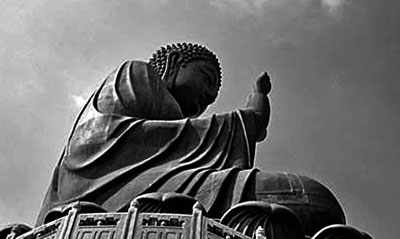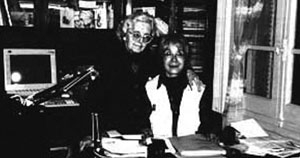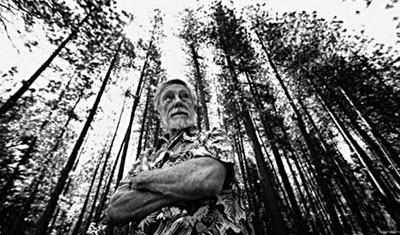|
anarchy and religions / 2
Anarchist Buddhism?
byFederico Battistutta
What relationship can exist between a political doctrine developed within the labor movement and socialism in the 800 and a religious movement arose in India in the sixth century BC?
|
 Paradoxical Statement Paradoxical Statement
Pushing anarchism and Buddhism can appear a risky operation. What relationship can exist between a political doctrine developed within the labor movement and socialism in the nineteenth century and a religious movement that arose in India in the sixth century BC.? It is true that both are, respectively, more than a political thought and a religious so that, when viewed as 'world views', have something to say outside of the areas in which they were born.
Let's start with an assertion that may seem paradoxical: Buddhism can be considered an-archic the extent that shrinks from saying about the existence of first principles. But in fact it is so: Buddha's teaching is based on two key words: anicca and anatta. The first term means 'impermanence', and states that there is no immutable condition for every and any phenomenon, but just an ongoing saga. The second, indicating the absence of an individual and permanent ego. Both are a denial of two founding principles (αρχή-arche) of the Brahmanic tradition in India. Not only that Buddhism is a-theoretical, because a priori denies not the existence of one or more gods (the negation would, in turn, the affirmation of a strong principle, albeit in a negative way), but in the sense that is apart from the question of theology. The core of research and teaching of the Buddha touches the life of man and his pain. (1)
This stretch of an exquisitely an-archico the way of Buddha is so marked that some Western scholars have shown more of an uncertainty in regard Buddhism as a religion.

 The way of Buddha The way of Buddha
We also note that the words listed above anicca and anatta, as anarchy, have the prefix an-(we call 'Greek alpha privative'). Now the letter A, even before the ultimate symbol of the anarchist movement, is also a real symbol of Buddhism, to the point of being described as "the supreme wisdom in one letter" is not only the first letter of the alphabet, thus indicating the beginning of linguistic communication, but especially the privative prefix to be affixed to all the concepts that are denied by the perfect vision of the wisdom of Buddha (prajnaparamita), as considered as words that refer to entities without a own reality.
So, support the impermanence of all being, to support the non-existence of a immortal soul, do not support the relevance of a theological foundation, brings in its immediate consequence of the denial of every principle of authority. There is a minor text in the speeches of Buddha, the KÄlÄmasutta, that is addressed to Kalam (name of a people or a clan). Since many preachers had gone from these people and they all had proclaimed the truth of their doctrine, denying value to other teachings, as Buddha was placed in the following question: how can we distinguish truth from falsehood? The reply was sharp: "Do not be led by hearsay, tradition or hearsay. Do not be guided by the authority of religious texts, or only by logic or by inference, nor by considering appearances, nor by the delight of speculation, neither the likelihood nor the idea 'this is our teacher'. But when you understand yourself, or Kalama, that certain things are wholesome and good, then accept them and follow them. "But, in this regard, particularly noted is the last speech of the Buddha, which says: "Be a lamp for yourself, take refuge in yourself and not the other."
In Zen Buddhism (a current kind in China, then spread to Japan, on which I will deal more) is a famous saying: "If you meet the Buddha, kill him!" This statement is surprising, no a priori precise meaning. Perhaps it has none, perhaps it has one hundred thousand. Surely there is the complaint of the danger of believing in a model of perfection out of us - the Buddha - to adhere slavishly. But, it is suggested, that model does not exist, it's just an idol created by our minds, obtained by reversing the sign of what we perceive as 'negative'. Killing the Buddha could mean finally turning to what is, to know as it is, without wanting to change at any cost but in a totally abstract way, but this is also the only way to create that space where your change can really happen.( 2)
 Between obedience and rebellion Between obedience and rebellion
But, unlike anarchism, Buddhism does not express a strictly social-political doctrine, is primarily a way of knowledge on the 'job for life ', whose goal is liberation from the pain inherent in the very fact of existing.
Furthermore, although Buddhism is often found in positions against the trend, when it is given a hierarchical and institutional structure is finished in more than one juncture to collude with the various holders of the established order, as was the case in the West Christianity. As an example of what you're saying you may refer to a historical study, highly documented, made by Brian Victoria - a Zen Buddhist monk U.S. citizen who lived many years in Japan - in which he highlights the support given by Japanese Buddhists to fifty years of wars of aggression by the Empire of the Rising Sun, by surfacing so unfortunately undeniable links between the Japanese Zen Buddhism of the early twentieth century and those of German Nazism and fascism Italian. (3) This text, beyond the intent of 'author are primarily for research and historical documentation, it is very important to understand and expose the dangers that any religion runs (and is running the society in which prosperity), when it decides to support and institutionalize the policy choices of a state. Religious values can not be imposed either by law or with the use of force, otherwise they are completely deprived of any relationship with the raison d'être of the religion itself.
That said, there are exceptions that seem to want to redeem Japanese Buddhism from the dark pages of its long history, traceable to the anarchic array that is its origin. As the story of Uchiyama Gudo (1874 - 1911), the Soto Zen school, involved in the affairs of high treason in 1910, which saw involved not only him, dozens of anarcho-socialists. The text from the resume of Brian Victoria.
Uchiyama Gudo, sorted Monaco in 1897, at the Hozo-ji temple, later became abbot of Rinsen-ji Temple located in a rural and mountainous region of Japan. This temple was rather small and it was a meeting place for religious farming community. Dialogue with young people of the village Gudo became the spokesman for agricultural reform that balances the social injustice created by the ownership of land by landowners.
Gudo argued that authentic experience is based on a Buddhist monastic community in which everyone, including high-ranking monks, dressed alike, ate the same food, worked the same land. Not only that Gudo this model of life based on equality could be spread to the entire society. Its social model was then the old sangha (community) with his Buddhist communal lifestyle, free from any form of private property.
Gudo in 1904 met the periodic anarcho-socialist "heimin Shimbun", thus verifying the correspondence between his ideas and those advocated by this newspaper. This led him to the knowledge that he too was an anarcho-socialist, at this point, he decided to start a close cooperation with this magazine, by which he was able to make public his beliefs on the relation between the principles of Buddhism with those of anarchism and socialism. But soon, in 1905, the newspaper had to be closed on the orders of the authorities. This is not silenced the protest movement: the riots and the demonstrations continued, even against the Russian-Japanese War in progress in those years. After opposition parties were banned, unable to conduct any legal activity, some decided to go to the 'direct action', similar to that of the anarchist movements in Europe, planning an attack on the imperial family.
In this period Gudo is outfitted with a clandestine print shop, setting it in its own temple, behind the altar of Buddha. Gave way to the press and disseminated numerous anarcho-socialist publications and one of his works. But May 24, 1909, while he was returning from Eihei-ji temple, was arrested, initially on charges of violating press laws. Later, the police claimed to have found materials to build explosive devices in his temple. So, after the imprisonment of other opponents of treason, Gudo and his companions were tried and executed for plotting to assassinate the emperor, in 1911. Two years earlier, officials of Soto Zen had struck him from the monastic order.
 |
Misato Toda with Luce Fabbri |
 Malatesta and the Zen monac Malatesta and the Zen monac
As for the relationship between Zen Buddhism and anarchism, also in Japan, the report deserves more recent contribution of Misato Toda, a Japanese university professor, a very competent scholar of the thought of Errico Malatesta, which he then expanded his interests to the characters of anti-fascism such as Piero Gobetti, Carlo Rosselli and Camillo Berneri. Misato Toda, gave a talk on anarchism from the perspective of Zen Buddhism, at the Oriental Institute of Naples, in 1983, in which they are presented with skill and lightness of touching points - as well as the differences - between anarchism and Buddhism , quoting and comparing those of Malatesta and Dogen Zenji, founder of one of the Japanese Zen current. According to the author, Buddhism and anarchism, in the sense of wanting ways of living and thinking, there is no contradiction: "We can not escape our destiny, which requires us to live with others and die alone. " We can say that this simple phrase summarizes well the possible meeting between these two apparently distant worlds, allowing you to tap into a hug that is our condition as social animals in search of a life worth living, both the direct and intimate relationship along yourself. (4)
 |
Gary Snyder |
 In America In America
It is no coincidence, then, if really Zen Buddhism - which has tried to achieve in its most radical (in the sense of being able to go to the root) the testimony left by Buddha - has attracted Western authors with strong libertarian sensibility.
This is the case of Gary Snyder, poet, essayist U.S., who took part in the experience of the beat generation and was one of the most serious scholars of Buddhism in this current. (5)
He spent part of the years between 1956 and 1968 in Japan, studying and practicing Zen in some major monasteries in Kyoto. But he is also a Bioregionalist and an active social critic. This dual interest is explained in a paper of 1961, republished with some changes a few years later, even if taken in similar positions are found in his other texts. The title speaks for itself: Buddhist Anarchy. (6)
In it we read this phrase that takes us back to the previous quote from Misato Toda, as the story of Uchiyama Gudo: "the gift of the West has been social revolution. The gift of the East was the individual vision that permeates the universe are basically empty interior and exterior. We need both. "Here, Snyder offers a summary on the one hand there is the tradition of the labor movement, strikes, protests and claims of community and social compassion, the other is triggered by the recognition of impermanent nature of everything. One is not the negation of the other, rather they may complement and support each other. It is on this basis that maybe it can grow and develop Buddhism in the West. In the words of a classic text of Tibetan Buddhism: "The concept of nothingness creates the pity. The mercy abolishes the difference between self and others. The mix itself with the other realizes the cause of others. He realizes that the cause of others will find me. The one that found me will be Buddha" (7).
 Federico Battistutta Federico Battistutta
Notes
- On this one focused in an exemplary manner Raimon Panikkar, in the book The Silence of Buddha. An a-religious theism, Milan, Mondadori, 2006. Buddha's atheism is not described here as a contrast to the various more or less surreptitious forms of theism in the rational affirmation of nonexistence of God, but is an expression of religiosity finally purified from the shadow of idolatry, which often darkens religions.
- Also on this wave, say, an important leader of Chinese Buddhism: "Do not think that the Buddha is the key. From my point of view it is just like the hole in the latrine. "The collection of Lin-chi, edited by Ruth Fuller Sasaki, Rome, Ubaldini, 1985.
- Brian Victoria, Lo zen alla guerra, Dogliani (CN), Sensibili alle foglie, 2001.
- The original text of the conference can be found at the CIRA (Centre International de Recherches sur l'Anarchism) in Lausanne. Misato Toda, in Italian, cf. Errico Malatesta from Mazzini to Bakunin, Naples, Guida, 1988, as well as some interventions have appeared in the pages of "A".
- On the relationship between Buddhism and the Beat Generation cf. also: Jack Kerouac, the empty dream universe. Essays on Buddhism, Milan, Mondadori, 1996, and Alan W. Watts, Beat Zen, and Other Essays, Rome, Arcana, 1973..
- Gary Snyder, Buddhist Anarchy in The Other America of the Sixties, edited by Fernanda Pivano, vol. I, Roma, Officina, 1971. The new version of the text in question is entitled: Buddhism and the revolution to come, is located in Gary Snyder, the texture of things, Torino, Gruppo Abele, 1987. Also on Zen Buddhism also has approached Ken Knabb, a U.S. anarcho-situationist, talks about the autobiographical pages of a weighty volume that collects several of his writings. See Ken Knabb, Public Secrets, Berkeley, Bureau of Public Secrets, 1997. By the same author reads: Two essays on Engaged Buddhism, which I translated to "The Morning Star", n.4/2003.
- Vita di Milarepa, Life of Milarepa, by Jacques bacote, Milano, Adelphi, 1966.
|
  
|

